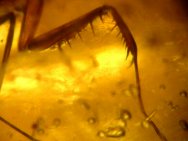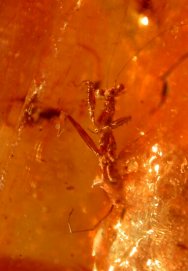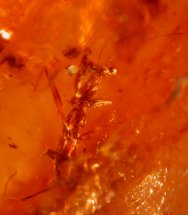Fossil
Amber Insects:
Praying Mantis and Insecta Orders Orthoptera, Homoptera, Isoptera, Hymenoptera,
and Coleoptera represented
Geologic
Time: Pliocene
to Pleistocene
Size: Amber
113 mm long, 53.9 grams
Fossil Site:
Andean Uplift Region, Andes Mountains, Colombia
| 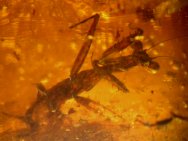 This
larger piece of amber is a magnificent showcase for one of the
most sought-after of inclusions: a 12 mm Praying Mantis.
Members of
the
Mantidae are not as harmless as the name suggests in that their
forelegs are equipped with spines on both the tibia and femur.
Mantids
sit in an upraised position (much as this one has been preserved)
lying in wait for unsuspecting prey (making them also a preying
mantis!). This
larger piece of amber is a magnificent showcase for one of the
most sought-after of inclusions: a 12 mm Praying Mantis.
Members of
the
Mantidae are not as harmless as the name suggests in that their
forelegs are equipped with spines on both the tibia and femur.
Mantids
sit in an upraised position (much as this one has been preserved)
lying in wait for unsuspecting prey (making them also a preying
mantis!).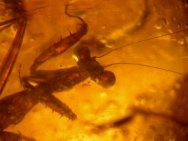 Notice the eyes in the very mobile head which allow the Mantids
an execellent means of scouting for prey. While they bear some
similarities
to their Orthopteran relatives the Cockraoches (Blattidae), there
are many easily recognized differences. There are several other
Orders
of Insecta included in the amber: Coleoptera: A fine Beetle; The
Planthopper (Order Homoptera, most likely Family Fulgoridae) is
a fine one
with
color preservation – this family holds the largest of the
Planthoppers. They are accompanied by a number of flies and midges
(Order Diptera), an ant, a small wasp, and a stingless bee (Order
Hymeoptera), and several wings of Alates (Flying Termites—Isoptera).
Mantids are quite rare inclusions in fossil amber.
Notice the eyes in the very mobile head which allow the Mantids
an execellent means of scouting for prey. While they bear some
similarities
to their Orthopteran relatives the Cockraoches (Blattidae), there
are many easily recognized differences. There are several other
Orders
of Insecta included in the amber: Coleoptera: A fine Beetle; The
Planthopper (Order Homoptera, most likely Family Fulgoridae) is
a fine one
with
color preservation – this family holds the largest of the
Planthoppers. They are accompanied by a number of flies and midges
(Order Diptera), an ant, a small wasp, and a stingless bee (Order
Hymeoptera), and several wings of Alates (Flying Termites—Isoptera).
Mantids are quite rare inclusions in fossil amber.
|
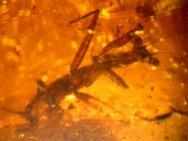
|
|
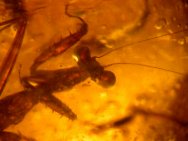
|
|
|
|
|
|
|
|
|
|
|
|
|
|
|



